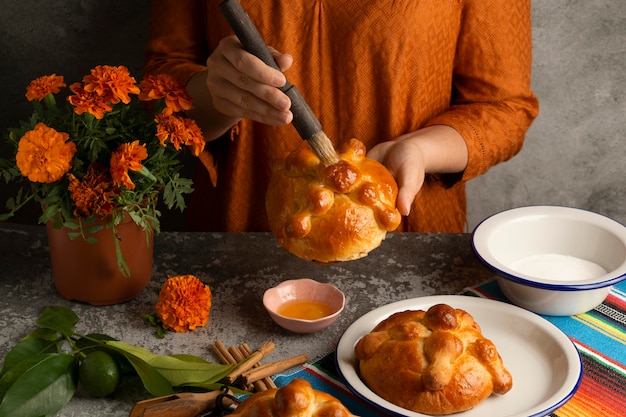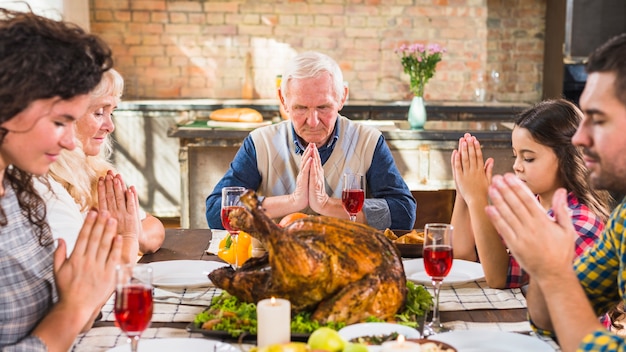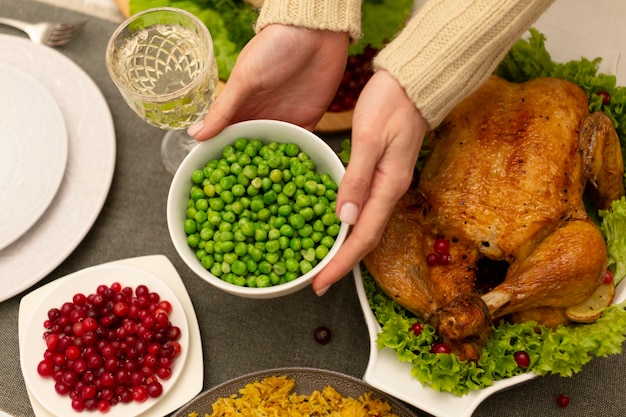Ah, the glorious turkey. It's the centerpiece of many festive gatherings, especially Christmas dinner. But let's be honest, roasting an 18-pound turkey can feel like a monumental task. You've got the weight, the timing, and the whole "don't overcook it" pressure. Don't fret, though! I'm here to guide you through the process, sharing my personal tips and tricks based on years of turkey roasting experience. From prepping to cooking to using up those delicious leftovers, we'll cover it all.
(Part 1) The Great Turkey Debate: To Stuff or Not to Stuff?

It all starts with a decision: stuffing. Do you stuff the turkey, or leave it unstuffed? This is a personal choice, but it can have a big impact on your cooking time and food safety. For me, stuffing the turkey is a cherished tradition, a delicious blend of herbs, vegetables, and bread that adds a special touch to the feast. But in recent years, food safety guidelines have shifted the tide toward separate stuffing.
The Food Safety Factor: A Crucial Consideration
Let's talk about the elephant in the room: food safety. The USDA recommends cooking turkey to an internal temperature of 165 degrees Fahrenheit (74 degrees Celsius). This ensures it's safe to eat, killing any harmful bacteria. Now, with stuffing inside the turkey, it's harder to reach that safe temperature. The stuffing often holds moisture, creating a potential breeding ground for bacteria.
Stuffing Separately: A Safer and More Controllable Option
The solution? Separate stuffing! It's a win-win. You get a perfectly cooked turkey, free of any potential food safety concerns. And you gain more control over the stuffing's cooking process, adjusting the oven temperature and timing to ensure it's cooked through. Plus, it allows you to get really creative with your stuffing flavours and textures.
(Part 2) Getting Ready: The Turkey Prep

Now that we've tackled the stuffing dilemma, let's get into the pre-roasting prep. A few key steps ensure a juicy, delicious turkey.
The Turkey Trot: Thaw It Out!
If your turkey is frozen, thawing is your first priority. The safest method is thawing in the refrigerator. It takes about 24 hours for every 5 pounds of turkey to thaw, so plan ahead! For an 18-pounder, you're looking at about 3-4 days. It's a slow and steady process, but it’s worth it for safety and a better outcome.
Pat It Dry: No Soggy Bird Here!
Once your turkey is thawed, pat it dry thoroughly with paper towels. This is crucial for achieving that crispy skin we all crave. A damp turkey won't get that golden brown, satisfying crunch.
Salt It Up: Seasoning for Success
Now comes the fun part! It’s time to season your turkey. I prefer a simple blend of salt, pepper, and herbs like rosemary and thyme. But feel free to unleash your creativity and experiment with spices you love. For maximum flavour, rub the seasoning under the skin as well as on the outside. This helps infuse the turkey with deliciousness from the inside out.
(Part 3) The Oven and the Turkey: A Perfect Pairing

Now, let's talk about the oven, the essential tool for transforming your raw turkey into a festive feast. The oven temperature is key, ensuring your turkey cooks evenly and achieves the perfect texture. For an 18-pound turkey, 325 degrees Fahrenheit (163 degrees Celsius) is the ideal temperature.
The Right Rack: Positioning is Key
Placement matters. Place your turkey on a roasting rack in a large roasting pan. This allows air to circulate around the turkey, promoting even cooking and preventing it from sitting in its own juices. And remember, give your turkey some breathing room! Don’t overcrowd the pan; it needs space to cook properly.
The Secret Weapon: Basting!
Basting is a game-changer, folks! It's the key to a juicy, flavorful turkey. Use pan drippings or chicken broth to baste your turkey every 30-45 minutes. It may seem like a lot of work, but the results are worth it.
(Part 4) Turkey Cooking Time: The 18-Pound Challenge
So, you've prepped your turkey, seasoned it, and chosen your oven temperature. Now the big question: how long does it take to roast an 18-pound turkey? It's all about timing, and there are a few factors to consider.
The Rule of Thumb: Time and Weight
For an unstuffed 18-pound turkey, you're looking at roughly 4-5 hours of roasting time. This is based on a general rule of thumb: 15 minutes per pound for an unstuffed turkey.
Don’t Forget to Rest: Let It Cool!
Once your turkey is cooked through, let it rest for about 30 minutes before carving. This allows the juices to redistribute, resulting in a more succulent and flavorful turkey.
The meat thermometer: Your Best Friend!
Remember that internal temperature we talked about earlier? A meat thermometer is your most reliable tool. It ensures your turkey is cooked through and safe to eat. Insert the thermometer into the thickest part of the thigh, not touching bone. The turkey is fully cooked when the thermometer reads 165 degrees Fahrenheit (74 degrees Celsius).
(Part 5) Taking the Temperature: Signs of Doneness
While a thermometer is your best friend, there are a few visual cues that indicate your turkey is ready.
The Skin Test: Golden Brown and Crispy
The skin should be a beautiful golden brown and crispy, which is a sign of even cooking and delicious browning.
The Leg Test: Easy Movement
If you wiggle the leg, it should move easily. The juices running from the thigh should be clear, not pink.
(Part 6) Let’s Talk About Leftovers: Putting Them to Good Use!
The turkey is cooked, the sides are ready, and everyone is digging in. But what about those inevitable leftovers? Don't be afraid of them! Leftover turkey is a delicious blank canvas for creative culinary adventures.
Sandwiches: A Classic Choice
Let's start with a classic: turkey sandwiches. Use leftover turkey with your favourite bread, cheese, and condiments. You can't go wrong with this simple yet satisfying option.
Soup: Warm Up With Turkey
A hearty turkey soup is a perfect way to use up leftover turkey, vegetables, and broth. Classic turkey noodle soup is always a winner, but feel free to get creative with flavours and spices.
Salads: A Lighter Option
Add chopped turkey to salads for a boost of protein and flavour. Pair it with fresh greens, cranberries, pecans, and your favourite dressing. It's a refreshing and satisfying meal.
Pasta: A Hearty and Delicious Meal
Diced turkey adds a delicious dimension to pasta dishes. Use it in creamy carbonara, pesto pasta, or a simple tomato sauce. It's a versatile ingredient that complements a variety of flavours.
Pot Pies: A Comforting Treat
Transform your leftovers into a comforting pot pie! Use a flaky pie crust to enclose a filling of turkey, vegetables, and gravy. It's a satisfying and heartwarming meal that's perfect for chilly days.
(Part 7) Mastering the Art: Tips and Tricks for Success
Now that we've covered the basics, let's explore some helpful tips and tricks to elevate your turkey roasting game.
Brining: A Secret Weapon for Moistness
Brining is a game-changer for turkey moisture. It involves soaking the turkey in a salt water solution for several hours or overnight.
- How to brine: Dissolve salt in water and submerge the turkey in the brine. You can add herbs, spices, and even citrus fruits for extra flavour.
- Brine time: For an 18-pound turkey, a brine time of 12-24 hours is ideal.
- Brining equipment: You can use a large stockpot or a cooler for brining.
Butterflying: A Space-Saving Technique
butterflying a turkey is a great way to save space in your oven and ensure even cooking.
- Butterfly technique: Cut along the breastbone to open the turkey up. Spread the turkey flat, then fold it in half.
- Butterflying benefits: It allows the turkey to cook faster and more evenly.
Spatchcocking: Faster Cooking, More Flavor
Spatchcocking is another technique for faster cooking and enhanced flavour.
- Spatchcock technique: Remove the backbone of the turkey, flatten it, and roast it skin-side up.
- Spatchcocking benefits: It allows the turkey to cook more evenly and develop crispy skin.
(Part 8) Turkey Roast timing guide: A Cheat Sheet
Here is a quick reference table for roasting turkey cooking times:
| turkey weight (lbs) | Unstuffed Cooking Time (hrs) | Stuffed Cooking Time (hrs) |
|---|---|---|
| 8-12 | 2-3 | 3-4 |
| 12-16 | 3-4 | 4-5 |
| 16-20 | 4-5 | 5-6 |
Important Note: Always Check for Doneness
Remember, this is just a guide. It's always best to use a meat thermometer to ensure your turkey is cooked through.
(Part 9) FAQs: Your Turkey Roasting Questions Answered
You’ve got questions, I've got answers. Let's tackle some common turkey roasting queries.
1. What if My Turkey Is a Bit Overcooked?
Don't worry, it's not the end of the world! An overcooked turkey might be a little dry, but you can still salvage it. Slice the turkey thinly, and use it in sandwiches, salads, or soup. The flavour is still great, even if it’s not quite as moist as you hoped for.
2. Can I Freeze Leftover Turkey?
Yes, you can freeze leftover turkey for up to 4 months. To freeze it, wrap the turkey tightly in plastic wrap or aluminum foil, and place it in a freezer-safe container.
3. How Long Should I Let the Turkey Rest Before Carving?
Let your turkey rest for 30 minutes after it’s cooked. This allows the juices to redistribute, giving you a more succulent turkey.
4. Is it Safe to Stuff a Turkey?
While stuffing a turkey is still a tradition for some, it’s generally recommended to stuff it separately. This ensures that the stuffing cooks through properly and doesn't get trapped inside the bird, which can lead to foodborne illness.
5. What Should I Do if My Turkey Breaks Apart While Carving?
If your turkey breaks apart while carving, don't panic! It’s a common issue, especially with larger birds. Just gather up the pieces, and use them in your favourite recipes. A little broken turkey doesn't affect the flavour.
There you have it, folks! Everything you need to know about roasting an 18-pound turkey. Now go forth and conquer, and remember, a little planning and patience go a long way in the turkey roasting game. Happy cooking!
Everyone is watching

Corn on the Cob: The Ultimate Guide to Perfectly Cooked Ears
Healthy MealsAh, corn on the cob. Just the name evokes images of sunny days, barbecues, and that sweet, juicy flavour that ...

Perfect Pork Roast Oven Cooking Time: A Guide to Delicious Results
Healthy MealsThere's something truly satisfying about a perfectly roasted pork. The aroma alone is enough to make your mout...

Ham Cooking Time: How Long to Bake, Smoke, or Boil a Delicious Ham
Healthy MealsAh, ham. It's a classic, isn't it? A real crowd-pleaser, especially around holidays. And when done right, it'...

Scallops: The Ultimate Guide to Perfect Cooking
Healthy MealsAh, scallops. Those delicate, sweet, and utterly delicious morsels of the sea. They hold a special place in my...

Spaghetti Squash: The Ultimate Guide to Cooking and Serving
Healthy MealsRemember that time you saw spaghetti squash at the supermarket, looking all bumpy and strange, and thought, "W...
